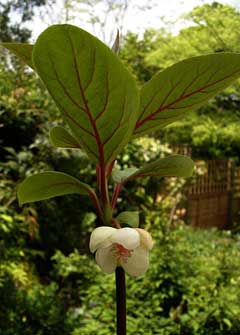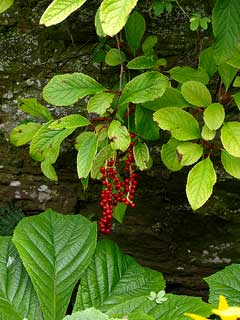 |
|
www.flickr.com/photos/peganum |
 |
| www.flickr.com/photos/12017190@N06 |
Translate this page:
Summary
Physical Characteristics

 Schisandra grandiflora is a deciduous Climber growing to 6 m (19ft 8in).
Schisandra grandiflora is a deciduous Climber growing to 6 m (19ft 8in).
See above for USDA hardiness. It is hardy to UK zone 8 and is frost tender. It is in flower from April to May, and the seeds ripen from August to September. The species is dioecious (individual flowers are either male or female, but only one sex is to be found on any one plant so both male and female plants must be grown if seed is required). . The plant is not self-fertile.
Suitable for: light (sandy), medium (loamy) and heavy (clay) soils and prefers well-drained soil. Suitable pH: mildly acid, neutral and basic (mildly alkaline) soils. It can grow in semi-shade (light woodland). It prefers moist soil.
UK Hardiness Map
US Hardiness Map
Synonyms
Kadsura grandiflora.
Plant Habitats
Woodland Garden Sunny Edge; Dappled Shade; Shady Edge; East Wall. By.
Edible Uses
Edible Parts: Fruit
Edible Uses:
Fruit - raw or cooked[2, 105, 177]. A pleasantly acid flavour[2], they make a nice dessert fruit[K]. The fruit is about 6mm in diameter and is borne in a grape-like bunch about 12cm long[200].
References More on Edible Uses
Medicinal Uses
Plants For A Future can not take any responsibility for any adverse effects from the use of plants. Always seek advice from a professional before using a plant medicinally.
None known
References More on Medicinal Uses
The Bookshop: Edible Plant Books
Our Latest books on Perennial Plants For Food Forests and Permaculture Gardens in paperback or digital formats.

Edible Tropical Plants
Food Forest Plants for Hotter Conditions: 250+ Plants For Tropical Food Forests & Permaculture Gardens.
More

Edible Temperate Plants
Plants for Your Food Forest: 500 Plants for Temperate Food Forests & Permaculture Gardens.
More

More Books
PFAF have eight books available in paperback and digital formats. Browse the shop for more information.
Shop Now
Other Uses
References More on Other Uses
Cultivation details
Prefers a rich well-drained moisture retentive soil[11, 200]. Prefers a slightly acid soil but tolerates some alkalinity if plenty of organic matter is added to the soil[200]. Requires some protection from the most intense sunlight[200]. Prefers light shade but tolerates full sun if the soil is reliably moist and the roots are in shade[202]. Plants are intolerant of drought[K]. The fully dormant plant is hardy to about -15°c[184], though the young growth in spring can be damaged by late frosts. Plants are of slow to moderate growth rate[202]. The shoots are semi-twining, but plants often require some support by tying the plant in[202]. Dioecious. Male and female plants must be grown if seed is required. Another report says that the plants are monoecious (male and female flowers are separate but are found on the same plant)[182].
References Carbon Farming Information and Carbon Sequestration Information
Temperature Converter
Type a value in the Celsius field to convert the value to Fahrenheit:
Fahrenheit:
The PFAF Bookshop
Plants For A Future have a number of books available in paperback and digital form. Book titles include Edible Plants, Edible Perennials, Edible Trees,Edible Shrubs, Woodland Gardening, and Temperate Food Forest Plants. Our new book is Food Forest Plants For Hotter Conditions (Tropical and Sub-Tropical).
Shop Now
Plant Propagation
Seed - best sown in the autumn in a cold frame[200, 238]. Pre-soak stored seed for 12 hours in warm water and sow in a greenhouse in the spring[238]. Germination can be slow and erratic. Prick out the seedlings into individual pots when they are large enough to handle and grow them on in light shade in the greenhouse for their first 2 years. Plant them out into their permanent positions in early summer. Cuttings of half-ripe wood, 5 - 8cm with a heel, August in a frame. Overwinter in the greenhouse and plant out in late spring[11, 78]. Good percentage[78]. Layering of long shoots in the autumn[200].
Other Names
If available other names are mentioned here
Native Range
TEMPERATE ASIA: China (Xizang Zizhiqu (south)) TROPICAL ASIA: Bhutan, India (Himachal Pradesh, Uttar Pradesh, West Bengal (north), Sikkim), Nepal
Weed Potential
Right plant wrong place. We are currently updating this section.
Please note that a plant may be invasive in one area but may not in your area so it's worth checking.
Conservation Status
IUCN Red List of Threatened Plants Status :

Growth: S = slow M = medium F = fast. Soil: L = light (sandy) M = medium H = heavy (clay). pH: A = acid N = neutral B = basic (alkaline). Shade: F = full shade S = semi-shade N = no shade. Moisture: D = dry M = Moist We = wet Wa = water.
Now available:
Food Forest Plants for Mediterranean Conditions
350+ Perennial Plants For Mediterranean and Drier Food Forests and Permaculture Gardens.
[Paperback and eBook]
This is the third in Plants For A Future's series of plant guides for food forests tailored to
specific climate zones. Following volumes on temperate and tropical ecosystems, this book focuses
on species suited to Mediterranean conditions—regions with hot, dry summers and cool, wet winters,
often facing the added challenge of climate change.
Read More
Expert comment
Author
(Wall.)Hook.f.&Thoms.
Botanical References
1151200
Links / References
For a list of references used on this page please go here
Readers comment
© 2010, Plants For A Future. Plants For A Future is a charitable company limited by guarantee, registered in England and Wales. Charity No. 1057719, Company No. 3204567.